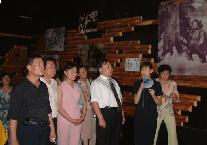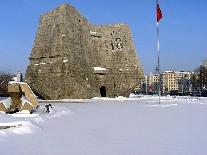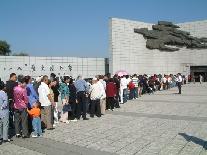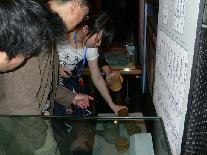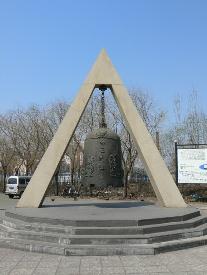ASIA
The September 18 History Museum (China)
(July 17, 2009)
by Gao Jian, Chief Researcher
On the night of September 18, 1931, the September 18 Incident (the Manchurian Incident) occurred at Liaotiao Lake in a suburb of Mukden (today’s Shenyang). The former Japanese Kwantung Army staged the incident and blew up a section of the former South Manchurian Railway. This museum stands on the site of the incident, and focuses on the incident as an important basis for education.
The museum opened in 1991 on the day commemorating the 60th anniversary of the incident. The new building was completed on September 18, 1999 with a nameplate rendered by former General Secretary Jiang Zemin. The spacious premises cover 35,000 square meters, and the buildings 12,000 square meters.
The bell that hangs in front of the memorial is inscribed with the phrase “Never forget our national humiliation.” Every year on the night of September 18, local administrative and economic leaders gather and sound the bell to convey the message “Never forget history, Value peace” to the next generation.
In the permanent exhibition, the occupation of China’s northeastern region by the former Japanese Imperial Army and Chinese resistance to it are explained. The theme is looking back on history and learning the importance of peace. Large numbers of photographs, documents, belongings of the victims, oil paintings, films, and sculptures are displayed with Chinese, Japanese, and English text. Visitors can also see a large reproduction of the human experimentation laboratory of the Kwantung Army’s Epidemic Prevention Water Bureau (Unit 731) which engaged in the development of biological weapons.
Nearly 20 years have passed since the museum opening. The number of visitors from home and abroad has exceeded 9 million. Among them are many Japanese government officials including Ryutaro Hashimoto and Tomiichi Murayama, former prime ministers. Based on the spirit of “Let history be a mirror, Hope for peace,” the museum aims, while striving to maintain peace in cooperation with Japan, to build a friendly future for the two countries.
Address: 46 Wanghua Nan Street, Shenyang, 21 110003 China
Phone: +86-(0)24-88331678
Days closed: Mondays
Admission: Free
(Originally published on July 6, 2009)
 Peace Museums of ASIA
Peace Museums of ASIA
